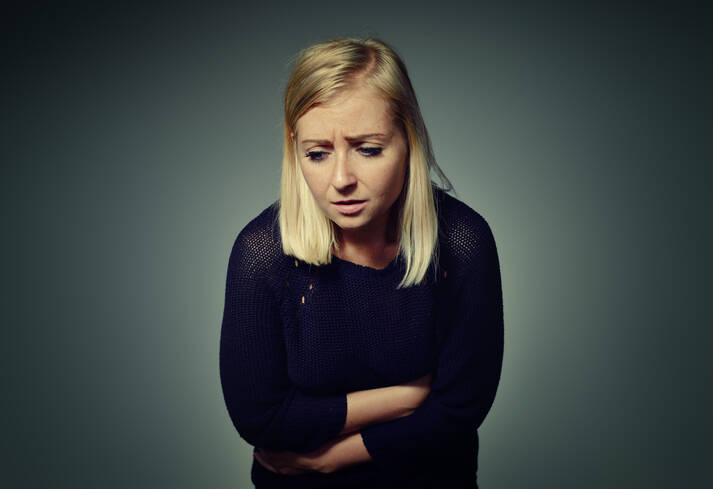- akv.sk - Gallstones - cholelithiasis
- nspskalica.sk - Gallstones can be a pain
- nemocnicapp.sk - Surgical removal of gallbladder - Cholecystectomy
When gallbladder stones come into play: what are the causes and symptoms?

Gallbladder diseases most often occur in connection with gallbladder stones. Why do these concrements form? How to avoid them or how to live with them, read in our article.
Article content
Gallbladder stones are the most common problem in gallbladder disease. Many people may not experience any symptoms and are unaware of their presence. However, when they do make themselves known, they cause significant discomfort and pain.
Cholecystolithiasis = gallstone (concretion) in the gallbladder.
Choledocholithiasis = concretion in the bile duct.
Gallbladder and bile ducts
The gallbladder is a hollow organ whose shape resembles a pear. It is located under the right lobe of the liver, i.e. in the area below the right rib arch. Its function is to collect and thicken bile.
This yellow-green fluid is needed for the proper digestion of fats and is formed by liver cells. It enters the gallbladder from the liver through the bile duct.
When food is ingested, the gallbladder receives a signal and expels the bile into the small intestine. Here it helps in the proper digestion of fats.
Gallbladder stones can be located in the gallbladder itself or in the bile ducts.
Why do gallbladder stones form?
Gallbladder stones may differ from one another in individual cases. The differences may lie in their composition or even size.
There are two basic types of gallbladder stones (table)
| Pigment gallstones | darker and smaller | usually contain bilirubin, a calcium salt |
| Cholesterol gallbladder stones | lighter, yellow-green formations | formed mainly as a result of high cholesterol levels |
The formation of gallbladder stones is directly related to poor lifestyle and inappropriate eating habits. Up to 80% of gallbladder stones are cholesterol stones.
These concrements are formed on the basis of several changes and disorders. These are mainly:
- oversaturation of bile with cholesterol
- the formation of cholesterol crystals in the bile
- impaired bile outflow
- inflammation of the gallbladder lining
The most common cause of their formation is an elevated level of cholesterol or bilirubin in the blood. Read also the article on elevated cholesterol.
Factors that contribute to the formation of stones
The risk of gallbladder stones increases with age. This disease is hereditary and on average affects more women than men. Increased levels of estrogen - female sex hormones - are thought to be the likely cause.
The formation of stones is influenced by:
- a diet high in cholesterol and saturated fatty acids
- fat digestion disorders
- obesity
- pregnancy
- poor lifestyle
- diabetes
- cirrhosis of the liver
- hereditary predispositions
You may also be interested in articles on the topic of overweight:
- What is the difference between overweight and obesity
- Obesity in children and young people, what to do against it?
- BMI calculation - know your body mass index
How do gallbladder stones manifest themselves?
Symptoms of the presence of gallbladder stones are initially non-specific. Some people live with gallbladder stones for even longer periods of time without significant difficulties.
Initial symptoms include:
- indigestion
- bloating
- flatulence
- nausea
- pain in the upper abdomen
- pain in the right side or sacral region
Biliary colic
A biliary attack (biliary colic) is a pain that is caused by spasmodic contraction of the muscles in the bile ducts. By alternately contracting and relaxing the muscles, the bile ducts try to expel the obstruction, thus clearing the way for the bile to drain.
Such an obstruction, in the form of a gallstone, is the source of severe cramping and throbbing pains. These are most often found in the area below the right rib arch. They may radiate up to the sacrum, under the right scapula, and even into the entire abdomen.
The condition is often accompanied by vomiting, fever and sweating. It appears several hours after an unsuitable meal. The most frequent occurrence is in the evening and at night.
Do you often feel similar pains and do not know what they may mean?
How to treat gallstones
Living with gallstones brings with it certain limitations. Each production and subsequent outflow of bile causes difficulties. At first, the symptoms are non-specific, later typical pain and indigestion appear.
Gallbladder stones are usually the cause, but gallbladder inflammation or gallbladder cancer can also cause similar problems.
Of course, the so-called gallbladder diet is a light diet with fat restriction. The food should be easily digestible, but at the same time varied and wholesome.
At present, there are no drugs to remove gallstones. They are only given to relieve pain.
The only way to remove the stones is by surgery, i.e. by removing the entire gallbladder and the stones. Nowadays, the so-called laparoscopic gallbladder surgery is particularly preferred.
In this operation, there is no classic surgical incision, but only four small incisions. Through these, the entire procedure is then carried out using special surgical tools. The advantage is less interference with the body and therefore a faster recovery for the patient.
What complications can arise during gallbladder stone surgery?
Although laparoscopic surgery is considered a minor intervention and poses less stress on the body, certain complications can still occur. These include bleeding, infection associated with suppuration or thromboembolism.
The latter can occur especially in patients who are lying down, smokers and women who are taking hormonal contraceptives. It is a condition where a blood clot forms and causes a blockage in a blood vessel, thus endangering life.
Read more about this disease in the article Thrombosis is not a disease of old people. It threatens the young too!
Other complications include:
- formation of adhesions in the abdominal cavity
- injury to the bile ducts or other organs during surgery
- allergic reactions
Prevention of gallstones
The formation of gallbladder stones causes considerable inconvenience and complications. Therefore, prevention of their formation is justified.
Be physically active
Regular sports or other physical activity significantly reduces the risk of stones. In addition, you will strengthen your health or improve your physical performance and vitality.
You can also take inspiration from our article: Create your own training plan
Eat healthy
Pay attention to your diet. You can reduce the risk of stone formation, especially if you include enough fibre in your diet. Don't forget to drink properly.
Read articles on this topic:
- Fiber as prevention and cure. How much do we need per day?
- How much fluid is too little and how much is too much?
Don't overeat
Eating unhealthy food or overeating has never been good for anyone's health. This also applies to the formation of gallbladder stones. Eat more often, but in small quantities. Your gallbladder and your whole body will thank you for it.
Don't forget breakfast
Bile is the most concentrated between meals. It is so important to expel this bile to prevent it from accumulating and thickening unnecessarily. Therefore, in the morning, when there is the biggest break between straight meals, have at least a small breakfast. This will kick-start your digestion properly.
Breakfast, as well as regular meals, will ensure the excretion of bile, which does not accumulate unnecessarily and does not pose such a risk of stones.
What to do when a gallbladder attack occurs?
Gallbladder stones easily cause pain, which usually occurs several hours after an inappropriate meal. Most often it is a fried, salty, fatty or spicy dish.
Whether you know about your gallbladder stone or not, you may be surprised by sudden, severe and unpleasant throbbing pain. Gallbladder colic makes normal activities impossible. It may also be accompanied by vomiting or fever.
Lie down, turn off the TV and try to find a position of relief.
Do not take any food at this time. The digestive system will benefit most from fasting at this time.
Warm compresses on the area of pain may provide some relief from cramps. The heat improves blood circulation, is soothing and relieves cramps.
Never apply warm compresses to injured skin. Always make sure the compress is not too warm. You could easily cause burns or other skin irritation.
You can take painkillers with a relaxing effect - spasmolytics.
Do not underestimate the pain and do not hesitate to contact a doctor, especially if it lasts more than a day. Also seek help if the pain is accompanied by fever or vomiting.
Interesting resources










